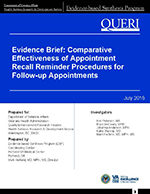
Investigators: Kim Peterson, MS; Ellen McCleery, MPH; Johanna Anderson, MPH; Kallie Waldrip, MS; Mark Helfand, MD, MPH, MS
Download PDF: Brief, Supplemental Materials
The objective of this evidence brief is to synthesize the literature on the comparative effectiveness of appointment recall reminder systems. The ESP Coordinating Center investigators and representatives of the Access and Clinic Administration Program (ACAP) worked together to identify the population, comparator, outcome, timing, setting, and study design characteristics of interest. The ACAP approved the following key questions and eligibility criteria to guide this review:
Key Question 1: For adult patients who are targeted for follow-up appointments, what is the comparative effectiveness of the current Class I VHA recall reminder software, alternative recall reminder software or approaches, or scheduling follow-up appointments at the time of leaving the office?
Key Question 2: For adult patients who are targeted for future appointments, does the comparative effectiveness of Appointment Recall Reminder (RR) procedures versus other kinds of follow-up appointment scheduling systems differ according to: